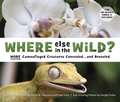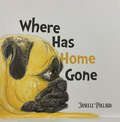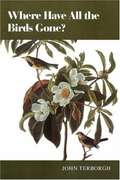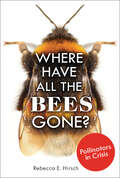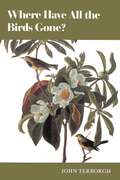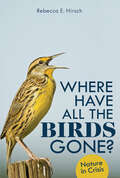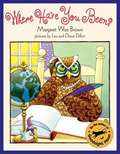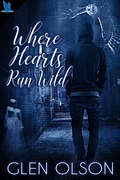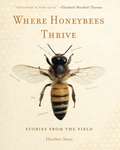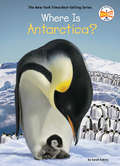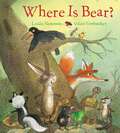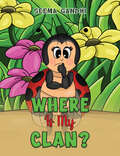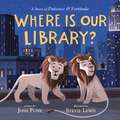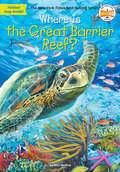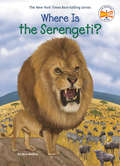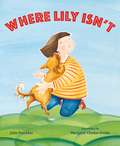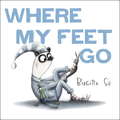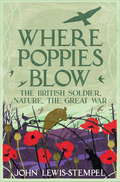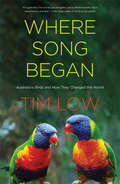- Table View
- List View
Where Else In The Wild?
by David M. Schwartz Yael Schy Dwight KuhnDid you find that sneaky orchid mantis hiding on the cover? This book is full of similarly sly species-and they're all hiding in plain sight. Think you've spotted one?<P><P> Lift the flap to find out Each of the camouflaged creatures on these pages, from chickadees to crayfish, is disguised for a reason.Some are on the prowl for prey, while others hide from hungry predators. Discover why geckos have a spooky reputation; why it pays for a mouse to have a dark-colored back and light-colored belly; and why you wouldn't want to be fooled by a scorpion fish.<P> In this follow-up to the acclaimed Where in the Wild?, David Schwartz, Yael Schy, and Dwight Kuhn take readers on another remarkable tour through the fascinating world of animal camouflage.
Where Has Home Gone
by Janelle PollardWhen Puggles woke up, none of his toys were to be seen. He knew it was not going to be a normal day. Home had vanished! What Puggles did not know was the adventures to come in finding his home: a motorbike ride, a boat trip and more. Come help Puggles find his home!
Where Have All The Birds Gone?: Essays On The Biology And Conservation Of Birds That Migrate To The American Tropics
by John Terborgh"Things are going wrong with our environment," writes John Terborgh, "even the parts of it that are nominally protected. If we wait until all the answers are in, we may find ourselves in a much worse predicament than if we had taken notice of the problem earlier. By waiting, one risks being too late; on the other hand, there can be no such thing as being too early." Terborgh's warnings are essential reading for all who care about migratory birds and our natural environment. Why are tropical migrant species disappearing from our forests? Can we save the birds that are left? Terborgh takes a more comprehensive view of migratory birds than is usual--by asking how they spend their lives during the half-year they reside in the tropics. By scrutinizing ill-planned urban and suburban development in the United States and the tropical deforestation of Central and South America, he summarizes our knowledge of the subtle combination of circumstances that is devastating our bird populations. This work is pervaded by Terborgh's love for the thrushes, warblers, vireos, cuckoos, flycatchers, and tanagers that inhabited his family's woodland acreage while he was growing upbirds that no longer live there, in spite of the preservation of those same woods as part of a county park. The book is a tour of topics as varied as ecological monitoring, the plight of the Chesapeake wetlands, the survival struggle of Central American subsistence farmers, and the management of commercial forests.
Where Have All the Bees Gone?: Pollinators in Crisis
by Rebecca E. HirschApples, blueberries, peppers, cucumbers, coffee, and vanilla. Do you like to eat and drink? Then you might want to thank a bee. Bees pollinate 75 percent of the fruits, vegetables, and nuts grown in the United States. Around the world, bees pollinate $24 billion worth of crops each year. Without bees, humans would face a drastically reduced diet. We need bees to grow the foods that keep us healthy. But numbers of bees are falling, and that has scientists alarmed. What's causing the decline? Diseases, pesticides, climate change, and loss of habitat are all threatening bee populations. Some bee species teeter on the brink of extinction. Learn about the many bee species on Earth—their nests, their colonies, their life cycles, and their vital connection to flowering plants. Most importantly, find out how you can help these important pollinators. "If we had to try and do what bees do on a daily basis, if we had to come out here and hand pollinate all of our native plants and our agricultural plants, there is physically no way we could do it. . . . Our best bet is to conserve our native bees." —ecologist Rebecca Irwin, North Carolina State University
Where Have All the Birds Gone?: Essays on the Biology and Conservation of Birds That Migrate to the American Tropics
by John Terborgh"Things are going wrong with our environment," writes John Terborgh, "even the parts of it that are nominally protected. If we wait until all the answers are in, we may find ourselves in a much worse predicament than if we had taken notice of the problem earlier. By waiting, one risks being too late; on the other hand, there can be no such thing as being too early." Terborgh's warnings are essential reading for all who care about migratory birds and our natural environment. Why are tropical migrant species disappearing from our forests? Can we save the birds that are left? Terborgh takes a more comprehensive view of migratory birds than is usual--by asking how they spend their lives during the half-year they reside in the tropics. By scrutinizing ill-planned urban and suburban development in the United States and the tropical deforestation of Central and South America, he summarizes our knowledge of the subtle combination of circumstances that is devastating our bird populations. This work is pervaded by Terborgh's love for the thrushes, warblers, vireos, cuckoos, flycatchers, and tanagers that inhabited his family's woodland acreage while he was growing upbirds that no longer live there, in spite of the preservation of those same woods as part of a county park. The book is a tour of topics as varied as ecological monitoring, the plight of the Chesapeake wetlands, the survival struggle of Central American subsistence farmers, and the management of commercial forests.
Where Have All the Birds Gone?: Nature in Crisis
by Rebecca E. HirschBirds are disappearing. Birds are nature's essential workers, and they are crucial members of ecosystems around the world. Hummingbirds pollinate our flowers; cardinals munch on beetles, grasshoppers, and other pests that damage crops; owls eat rodents that can spread disease; vultures clean up roadkill and other waste. Beyond their practical aspects, birds bring us joy through their songs and beautiful feathers. But since 1970, nearly 30 percent of all birds in the United States and Canada have vanished. Scientists are scrambling to figure out what may be causing such a drastic decline. The answer: humans. City lights and tall glass skyscrapers disorient migrating birds. Domesticated cats prowling outdoors kill billions of birds each year. Pesticides contaminate fish and insects, which are then consumed by birds of prey. And climate change might disrupt and even wipe out feeding grounds for entire species. Discover the vast impacts birds have on ecosystems, food systems, and human communities, and learn more about what scientists are doing to protect them. “Never have my astonishment, wonder, and admiration been so stirred as when I have witnessed these birds drop from their course like meteors from heaven.” —Simon Pokagon, Potawatomi tribal leader “In pushing other species to extinction, humanity is busy sawing off the limb on which it is perched.” — American biologist Paul R. Ehrlich “There’s something everyone can do in their lives and in their communities to make it a better place for birds and people.” — Gary Langham, chief scientist, National Audubon Society
Where Have All the Pandas Gone?
by Melvin Berger Gilda BergerWhere have all the pandas gone? From the bamboo forests of China--to near extinction. Today, there are only about 1,000 giant pandas left in the entire world. In the well-received conversational style that sets this series apart, this book explores three basic questions about endangered species: Where have these animals gone? Why are they disappearing? Are people saving them? The Bergers explain the disappearance of not only giant pandas, but also of mountain gorillas, monkeys, tigers, rhinoceroses, and bald eagles, to name a few.
Where Have You Been?
by Margaret Wise BrownAges 3-6 Where has the Little Old Cat been? To see this and that Said the Little Old Cat Where does the Little Old Fish swim? Wherever I wish Said the Little Old Fish . . . Have you ever wondered where a cat or a squirrel has been or where a bird flies or a whale sails? How about why a bunny runs? With playful, rhyming verse, WHERE HAVE YOU BEEN? Perfectly captures the wonderful, wise questions that children ask every day.
Where Hearts Run Wild
by Glen OlsonA cunning and wild horse gallops the Colorado open plains with the spirit of a storm. The wayward youth and the horse meet and recognize their likeness to one another. Magically an attraction is formed and the two venture into a world where reality rubs against their nature which can either result in success or failure – no middle ground, no compromises. The youth experiences a series of painful trials that twist and turn his life. The end result is a transformation into the light as he experiences a spiritual awakening in his darkest hours.
Where Honeybees Thrive: Stories from the Field (Animalibus)
by Heather SwanColony Collapse Disorder, ubiquitous pesticide use, industrial agriculture, habitat reduction—these are just a few of the issues causing unprecedented trauma in honeybee populations worldwide. In this artfully illustrated book, Heather Swan embarks on a narrative voyage to discover solutions to—and understand the sources of—the plight of honeybees.Through a lyrical combination of creative nonfiction and visual imagery, Where Honeybees Thrive tells the stories of the beekeepers, farmers, artists, entomologists, ecologists, and other advocates working to stem the damage and reverse course for this critical pollinator. Using her own quest for understanding as a starting point, Swan highlights the innovative projects and strategies these groups employ. Her mosaic approach to engaging with the environment not only reveals the incredibly complex political ecology in which bees live—which includes human and nonhuman actors alike—but also suggests ways of comprehending and tackling a host of other conflicts between postindustrial society and the natural world. Each chapter closes with an illustrative full-color gallery of bee-related artwork.A luminous journey from the worlds of honey producers, urban farmers, and mead makers of the United States to those of beekeepers of Sichuan, China, and researchers in southern Africa, Where Honeybees Thrive traces the global web of efforts to secure a sustainable future for honeybees—and ourselves.
Where Honeybees Thrive: Stories from the Field (Animalibus: Of Animals and Cultures #10)
by Heather SwanColony Collapse Disorder, ubiquitous pesticide use, industrial agriculture, habitat reduction—these are just a few of the issues causing unprecedented trauma in honeybee populations worldwide. In this artfully illustrated book, Heather Swan embarks on a narrative voyage to discover solutions to—and understand the sources of—the plight of honeybees.Through a lyrical combination of creative nonfiction and visual imagery, Where Honeybees Thrive tells the stories of the beekeepers, farmers, artists, entomologists, ecologists, and other advocates working to stem the damage and reverse course for this critical pollinator. Using her own quest for understanding as a starting point, Swan highlights the innovative projects and strategies these groups employ. Her mosaic approach to engaging with the environment not only reveals the incredibly complex political ecology in which bees live—which includes human and nonhuman actors alike—but also suggests ways of comprehending and tackling a host of other conflicts between postindustrial society and the natural world. Each chapter closes with an illustrative full-color gallery of bee-related artwork.A luminous journey from the worlds of honey producers, urban farmers, and mead makers of the United States to those of beekeepers of Sichuan, China, and researchers in southern Africa, Where Honeybees Thrive traces the global web of efforts to secure a sustainable future for honeybees—and ourselves.
Where Is Alfred?
by Mircea VasiliuJoin the adventure of Alfred and see what happens to an alligator who misses his home.
Where Is Antarctica? (Where Is?)
by Jerry Hoare Sarah Fabiny Who HqExplore Antarctica--the coldest, driest, and windiest continent on Earth--in this adventure-filled title in the Who HQ series.Antarctica, the earth's southernmost continent, was virtually untouched by humans until the nineteenth century. Many famous explorers journeyed (and often died) there in the hope of discovering a land that always seemed out of reach. This book introduces readers to this desert--yes, desert!--continent that holds about 90 percent of the world's ice; showcases some of the 200 species that call Antarctica home, including the emperor penguin; and discusses environmental dangers to the continent, underscoring how what happens to Antarctica affects the entire world.
Where Is Bear?
by Lesléa NewmanThe animals in the forest are playing hide-and-seek, and everyone is found--except for the biggest one of all! Where, oh where, could Bear have gone? One thing is certain: Bear's friends will do whatever it takes to find him. Lesléa Newman's rhythmic text and Valeri Gorbachev's charming illustrations will make every child eager to join this playful search for the missing Bear.
Where Is Magenta? (Blue's Clues Discovery Series, Book #3)
by Ronald KiddBlue gets a postcard from Magenta, who has gone on a vacation. But where has Magenta gone? Play Blues Clues to find out!
Where Is My Clan?
by Seema GandhiWhere Is My Clan? is a novel about a little ladybug wandering in search of her family. She comes across many animals in her search for her own clan. Carefully, the little ladybug comes across various collective names for each of these animals, and finally makes her way through and reunites with her family.
Where Is Our Library?: A Story of Patience and Fortitude
by Josh FunkWhere Is Our Library? is a companion to Lost in the Library and our second picture book in partnership with the New York Public Library.Curious Patience and steadfast Fortitude wait every morning to greet visitors of the New York Public Library—and slip away every night to read in the Children's Center.But one day, Patience and Fortitude find the Children's Center empty! The two lions set out into the city to locate their missing books and encounter some literary landmarks along the way.Josh Funk's clever rhymes and Stevie Lewis's vibrant art take young readers into the heart of New York City in this latest adventure.
Where Is the Great Barrier Reef (Where Is?)
by Nico Medina John HinderliterIn this Where Is? title, kids can explore the Great Barrier Reef--big enough to be seen from space but made up of billions of tiny living organisms.The Great Barrier Reef, off the coast of Australia, is the world's largest coral reef system. Stretching more than 1,400 miles, it provides a home to a wide diversity of creatures. Designated a World Heritage Site, the reef is suffering from the effects of climate change but this fascinating book shows this spectacular part of our planet. From the Trade Paperback edition.
Where Is the Serengeti? (Where Is?)
by Nico Medina Who HQIf you've never known what a wildebeest is, you'll find out now in this latest Where? Is title about the Serengeti.Each year, over 1.5 million wildebeest make a harrowing journey (more than one thousand miles!) between Tanzania and Kenya. They are in search of new land to graze. Even if these creatures avoid vicious attacks from lions and crocodiles, they could still fall prey to thirst, hunger, and exhaustion. This book not only follows the exciting Migration, but also tells about the other creatures and peoples that co-exist along these beautiful landscapes of the Serengeti.
Where Lily Isn't
by Julie PaschkisWhere Lily Isn't is Julie Paschkis and Margaret Chodos-Irvine's beautiful bereavement picture book celebrating the love of a lost pet.Lily ran and jumped and barked and whimpered and growled and wiggled and wagged and licked and snuggled. But not now.It is hard to lose a pet. There is sadness, but also hope—for a beloved pet lives on in your heart, your memory, and your imagination.
Where My Feet Go
by Birgitta SifA young panda's feet walk, run, swing, and splash through the day in this charming story for preschoolers that is also an ode to imaginative play, perfect for fans of the Chu's Day books. Meet Little Panda. He's awake and ready for adventure. Where will his feet take him? Do they walk a normal walk down a normal street? Or will they find a new way to carry him through the day? Maybe a tree branch can be a shaky bridge. A sandbox a desert. A bath an underwater adventure. Maybe little feet can go anywhere. . . . There's a whole world to explore! Young children will see themselves in Little Panda and find inspiration in Little Panda's big steps.
Where Poppies Blow: The British Soldier, Nature, the Great War
by John Lewis-StempelWinner of the 2017 Wainwright Golden Beer Book Prize for nature writingThe natural history of the Western Front during the First World War'If it weren't for the birds, what a hell it would be.'During the Great War, soldiers lived inside the ground, closer to nature than many humans had lived for centuries. Animals provided comfort and interest to fill the blank hours in the trenches - bird-watching, for instance, was probably the single most popular hobby among officers. Soldiers went fishing in flooded shell holes, shot hares in no-man's land for the pot, and planted gardens in their trenches and billets. Nature was also sometimes a curse - rats, spiders and lice abounded, and disease could be biblical.But above all, nature healed, and, despite the bullets and blood, it inspired men to endure. Where Poppies Blow is the unique story of how nature gave the British soldiers of the Great War a reason to fight, and the will to go on.
Where Poppies Blow: The British Soldier, Nature, the Great War
by John Lewis-StempelWinner of the 2017 Wainwright Golden Beer Book Prize for nature writingThe natural history of the Western Front during the First World War'If it weren't for the birds, what a hell it would be.'During the Great War, soldiers lived inside the ground, closer to nature than many humans had lived for centuries. Animals provided comfort and interest to fill the blank hours in the trenches - bird-watching, for instance, was probably the single most popular hobby among officers. Soldiers went fishing in flooded shell holes, shot hares in no-man's land for the pot, and planted gardens in their trenches and billets. Nature was also sometimes a curse - rats, spiders and lice abounded, and disease could be biblical.But above all, nature healed, and, despite the bullets and blood, it inspired men to endure. Where Poppies Blow is the unique story of how nature gave the British soldiers of the Great War a reason to fight, and the will to go on.
Where Song Began: Australia's Birds and How They Changed the World
by Tim LowTim Low, award-winning author of Feral Future, in an eye-opening book on the unique nature of Australian birds and their role in ecology and global evolution. Renowned for its unusual mammals, Australia is a land of birds that are just as unusual, just as striking, a result of the continent''s tens of millions of years of isolation. Compared with birds elsewhere, ours are more likely to be intelligent, aggressive and loud, to live in complex societies, and are long-lived. They''re also ecologically more powerful, exerting more influences on forests than other birds. But unlike the mammals, the birds did not keep to Australia; they spread around the globe. Australia provided the world with its songbirds and parrots, the most intelligent of all bird groups. It was thought in Darwin''s time that species generated in the Southern Hemisphere could not succeed in the Northern, an idea that was proven wrong in respect of birds in the 1980s but not properly accepted by the world''s scientists until 2004 - because, says Tim Low, most ornithologists live in the Northern Hemisphere. As a result, few Australians are aware of the ramifications, something which prompted the writing of this book. Tim Low has a rare gift for illuminating complex ideas in highly readable prose, and making of the whole a dynamic story. Here he brilliantly explains how our birds came to be so extraordinary, including the large role played by the foods they consume (birds, too, are what they eat), and by our climate, soil, fire, and Australia''s legacy as a part of Gondwana. The story of its birds, it turns out, is inseparable from the story of Australia itself, and one that continues to unfold, so much having changed in the last decade about what we know of our ancient past. Where Song Began also shines a light on New Guinea as a biological region of Australia, as much a part of the continent as Tasmania. This is a work that goes far beyond the birds themselves to explore the relationships between Australia''s birds and its people, and the ways in which scientific prejudice have hindered our understanding. ''Tim Low is the rare author who is able to turn complex and sophisticated research into a form digestible to the general reader without ''''dumbing down'''' the science . . . A brilliantly readable book that not only gives Australian birds recognition long overdue, but allows for a fresh understanding of the way the world (and particularly our island continent) functions. '' Sean Dooley, Sydney Morning Herald''Low has written a book that is highly informative, but also most readable. Twitchers everywhere will rejoice, but there is also much here that ordinary readers will enjoy. Where Song Began teaches us all a huge amount about our birds--not least that we should be very proud of them. Thoroughly recommended. '' Lucy Sussex, Sunday Age''Stuffed with the fruits of long experience, wide travels (is there anywhere Tim Low hasn''t been?) and deep research. '' The Saturday Paper''Esteemed Australian biologist Tim Low tells the incredible story of the origins of global bird life . . . And this story is exciting: ambitious in scope and filled with daring reconstructions of the past, Low''s provocative study turns a number of evolutionary assumptions on their heads . . . Low''s book will sensitise readers to their bird-filled environments and inject critical insights into ecological pasts and futures. '' Lucy Van, Readings Monthly''If you have an interest in natural history and the environment, read this book and you won''t look at Australia in quite the same way again . . . Crammed with intriguing facts and ideas . . . A serious feat of synthesis that few bird observers or natural historians, let alone few authors, would have the knowledge, experience, time or access to academic resources to pull together. '' Bob Beale, Sunday Age''The story . . . will be a revelation for most readers . . . crammed with intriguing facts and ideas . . . with outbreaks of first-class storytelling . . . Where Song Began is a serious fea...

